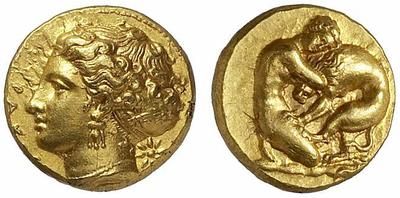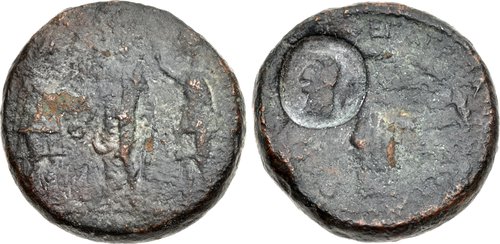There has been a tremendous explosion of interest in Greek coinage. This has been due primarily to the confidence NGC has inspired with its third party grading and authentication program. Many US coin dealers have now gotten into ancients, taking their vast client bases with them. Many of these collector/investors are sophisticated, educated individuals used to purchasing modern graded coins.
However, there are marked differences between the modern and ancient markets.

A) Very small differences in style, strike, metal quality, preservation - and die state, can make for huge differences in price. A Mint State coin in fine style and well struck from fresh dies might be worth three to five times a Mint State coin from the exact same issue of lesser style, with a middling strike from well used dies. To understand these differences one needs to look at thousands of coins - in person. Pictures can be difficult to interpret. The coin above is worth 2-3 times the coin on the right. Can you tell why?
B) The quantities of Ancients - even the most common Ancient coins - are so much smaller than those of "very rare" modern issues that auction results are often misleading and sometimes completely irrelevant. A coin that might not have come up at auction for a few years might go for three to five times what the exact same coin go for in a year when five or six examples coincidentally hit the auctions in the same year. Furthermore certain auction houses command huge premiums for certain issues, because they have different types of client bases. They can inspire bidding frenzies for common issues or middling coins when they are artfully combined with rarer issues in the right auction settings. At the same time, a coin might go for very little, simply because nobody bid that day, and by the time the next lot was up everybody was kicking themselves for missing it.

C) Historical Significance creates value. The coin above (From CNG 94) is amazing. Do you know why? Modern issues are rarely historically significant. In the modern era (from 1500 AD onward) Historical Significance is the provenance of medals and medallic issues which announced and commemorated important events. But ancient coins served this medallic function. Many ancient issues announced and commemorated important historical events. To understand the value of such coins one needs to know the history behind them.
D) There are no central records. With modern coins there are often recorded mintages, population reports, comprehensive guide books etc. With ancients none of this exists. Yes, there's AC search and other such on line guides. But these only go back a few years, only include certain auction houses and are partial at best even with the information they do include. They can help. But, as in many things, there's no short cut to extensive personal experience - both in the market and in the library, sifting through various specialized articles and books.
None of this is meant to be discouraging. In fact, quite the opposite. All these factors can be advantages for collectors willing to put in the time and effort. But those seeking quick short cuts to trading wealth will become quickly discouraged as they find their amazing deals to be worth very little on account of factors they will only come to understand much later.


No comments:
Post a Comment